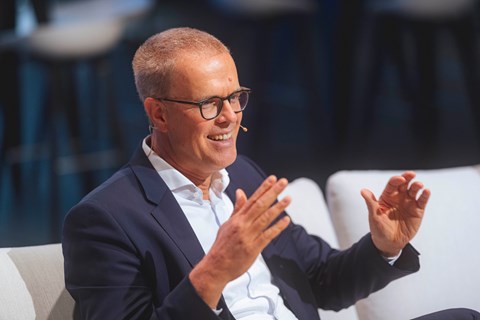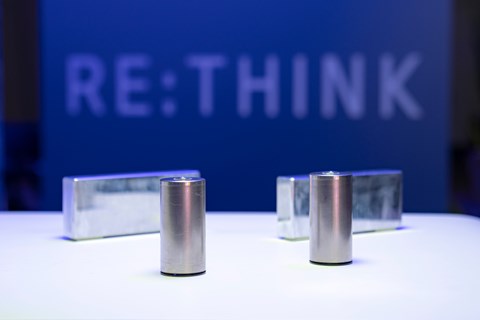► BMW’s Neue Klasse tech explained
► Electric-only mindset will be BMW’s biggest shift
► How will the business change?
BMW’s Neue Klasse era of cars is to kick off in 2025, with new generations of battery and e-motor technology as well as a real rethink in terms of how recycled parts can be used in new models, and how recyclable those cars can be at the end of their life cycle.
Frank Weber, BMW’s chief technology officer, didn’t beat around the bush at BMW Group’s recent Sustainability through Innovation conference: ‘with the New Class line-up, we are going to make a huge technology leap.’
The tech demonstrations took us through a new ‘pack-to-open-body’ concept (which allows BMW to tailor-make its battery sizes to fit any model, rather than have to make a set of modules fit by using round battery cells instead of prismatic ones) as well as some new sustainability measures and recycling techniques. ‘Our highly focused pack-to-open-body concept pioneers for instance a truly innovative approach to battery integration and final assembly,’ adds Weber.

Why is BMW doing all of this? Because some of the stats when it comes to manufacturing cars (and, indeed, much else) are alarming. The brand says $4tn-worth of materials for battery production are needed between now and 2050, 45 per cent of emissions are caused by raw material production and use, and only 9 per cent of all materials are currently recycled.
Some of these techniques are being incorporated into the Neue Klasse range of cars, which debuts in 2025 with an all-new i3 and the next-generation iX3.
So, how does a round battery cell help that?
The accompanying slide said more than a thousand words. It showed a body in white from below which was about to be mated to a single-piece full-size undertray laden with round energy cells, liquid cooling mats and performance electronics. While other manufacturers who pursue a similar cell-to-chassis concept try to fill every crevice with a battery or two, BMW is opting for an easyfit modular solution which in addition enhances the torsional rigidity, lowers the centre of gravity and supports repair and maintenance work.
The NC’s slim rectangular battery tray is no longer filled with pouches but with brand- new bottom-vent round cells supplied by CATL, EVE and Northvolt. Measuring 46mm in diameter and either 120 (SUV) or 95mm (saloon) in height, the batteries come in different chemical compositions to emphasize max power, extended range, slow degradation, or low cost. Individual elements used include nickel, lithium, manganese, iron, silicon and phosphate. All of that means a 20 per cent higher energy density, 30 per cent better packaging efficiency, up to 30 per cent more range and up 30 per cent quicker charging compared to the current batteries used.

‘The combination of an 800V system and a high-performance charger increases the range every minute by 30miles to a maximum of 375miles,’ says Weber. That’s about twelve minutes for a zero to 95percent power boost – which almost matches a trad pit stop for Super Plus and a coffee to go.
As for a solid state battery, BMW says the first prototype will be shown in 2025.
How much power are we talking?
Tomorrow’s BMW EV matrix can accommodate up to four e-motors, and the new DNA is sufficiently flexible to cater for the entire range from the 1-series right up to the full-size X7. While most future e-models are to feature straightforward RWD and AWD configurations with one or two current-excited synchronous SSM (separately-excited) units driving the rear wheels, the thoroughbred M cars are expected to boast a quad-motor layout for ultimate grip and extreme torque vectoring. In fact, BMW M is currently testing its own electric M car (pictured below) as we write this.

Why SSM instead of ASM (asynchronously-excited) or PSM (permanently-excited)? Because according to BMW, only SSM warrants a stable peak performance, high energy density, excellent repeatability, and low noise emission together with a 97percent efficiency rate.
The power output ranges from 268bhp up to a whopping 1341bhp. The battery packs match this awesome bandwidth: from 75kWh to a feisty 150kWh, anything is possible – but not necessarily practical. ‘Going big on cell power and extreme range is not the solution, because the size and weight penalty is counter-productive,’ says Frank Weber. ‘Instead, we must get the best out of every watt-hour by further reducing the rolling resistance, improving aerodynamics and increasing the on-board energy efficiency.’
What’s being done with the chassis, then?
Thomas Albrecht, head of Efficient Dynamics, claims that the New Class will beat previous architectures by at least 25 per cent in terms of aerodynamic efficiency. Apparently, there is a multi-zone active Autobahn mode in the works to further curtail drag above 70mph while at the same time improving the downforces through fast corners.
Also in the pipeline are so-called A+ tyres which allegedly cut the rolling resistance by up to seven percent. Modified low-loss wheel bearings and friction-optimized brakes contribute a further four per cent.
How will the Neue Klasse cars look?
When asked about the reportedly dramatic design changes which are in the works for the New Class, the CTO was suddenly surprisingly mum. ‘All I can say right now is that appearance-wise, the Neue Klasse cars will be breakthrough efforts which leave no stone unturned.’

Our intel suggests Weber and his chief stylists van Hooydonk and Dukec have a chosen a pragmatic and cost-efficient interim fusion between the current rodent-fang focused design and an altogether different front-end look, but that could change from 2030. One thing’s for sure: the ‘same shape for all’ formula pioneered by the 7-series and i7/X1 and iX1/X3 and iX3 sets of twins will remain.
The new low-drag i3, due in 2025, introduces different proportions defined by the cab-forward greenhouse, notably longer wheelbase, shorter front overhang and a unique slipstream rear end.
In the old-world order, the recently facelifted 3-series would have been phased out in 2025 in favour of the i3, but since demand for combustion engined BMWs isn’t waning, the marque’s best-seller is due to soldier on for at least five more years. It will however be brought visually close in line with the i3 the way the next 5-series and the 2025 i5 look similar to one another.